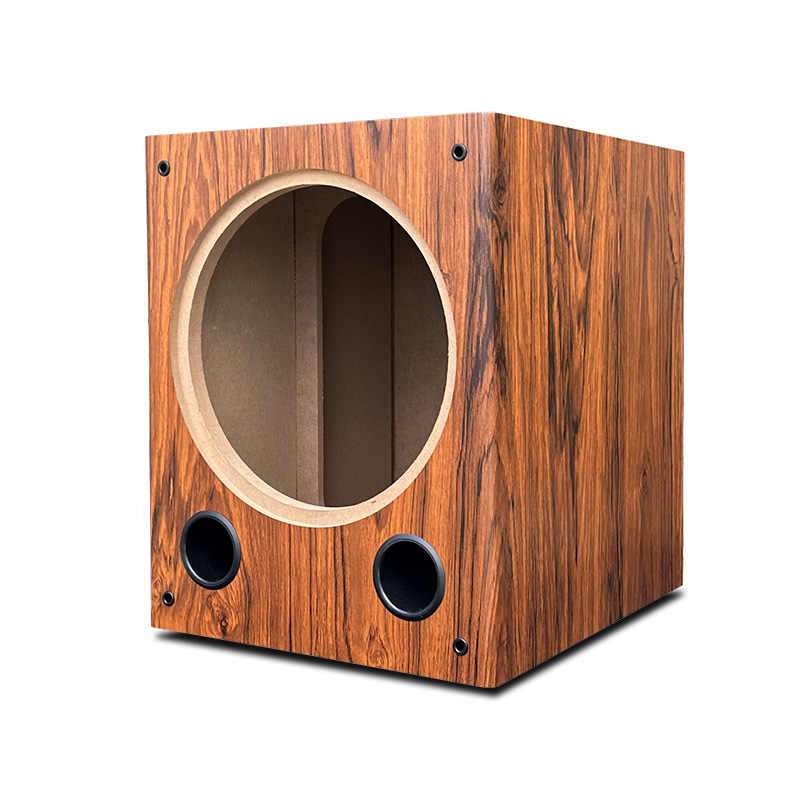
Creating a high-quality 12-inch subwoofer box (also known as 12 inch subwoofer box or 12 in subwoofer box) is crucial for achieving the best possible bass response in your audio system. Whether you’re setting up a home theater, car audio, or professional sound rig, a well-designed enclosure can make all the difference. In this guide, we will explore the key considerations for designing and building a 12 subwoofer and box, including technical data, drawings, and setup tips.
Why a Custom 12 Subwoofer Box?
- Optimized Performance: A custom 12 subwoofer with box allows you to tailor the enclosure to the specific characteristics of your subwoofer, ensuring optimal performance.
- Aesthetic Appeal: Building your own 12 subwoofer box gives you the freedom to match the design to your personal style and the aesthetics of your space.
- Cost-Effective: While there are many pre-built 12 subwoofer boxes available, building your own can be more cost-effective and allow for customization.
Key Considerations for 12 Subwoofer Box Design
When designing a 12 subwoofer box, several factors need to be considered to ensure the best possible sound quality:
- Subwoofer Specifications: Start by gathering the specifications of your 12-inch subwoofer, such as power handling, frequency response, and recommended enclosure volume.
- Enclosure Type: Decide on the type of enclosure you want to build. Common types include sealed, ported, and bandpass enclosures. Each has its own advantages:
- Sealed Enclosures: Provide tight, accurate bass and are ideal for music that requires fast, punchy bass.
- Ported Enclosures: Offer more volume and deeper bass extension, making them suitable for movies and electronic music.
- Bandpass Enclosures: Combine the benefits of both sealed and ported designs, providing a balance between accuracy and volume.
- Volume Calculation: Use the Thiele/Small parameters of your 12 subwoofer to calculate the appropriate internal volume of the enclosure. There are online calculators and software tools available to help with this.
- Material Selection: Choose high-quality materials such as MDF (Medium-Density Fiberboard) or plywood for the construction of your 12 subwoofer box. Ensure the material is thick enough to minimize resonance and vibrations.
- Internal Bracing: Add internal bracing to the 12 subwoofer box to reinforce the structure and reduce unwanted vibrations.
- Port Design (for Ported Enclosures): If you’re building a ported 12 subwoofer box, carefully design the port size and length to match the tuning frequency of the enclosure.
Step-by-Step Guide to Building a 12 Subwoofer Box
Materials and Tools Needed:
- MDF or plywood
- Wood glue
- Screws and nails
- Circular saw or jigsaw
- Drill
- Sandpaper
- Paint or wood finish (optional)
- Carpet or vinyl (optional)
Steps:
- Gather Specifications:
- Obtain the Thiele/Small parameters and recommended enclosure volume for your 12-inch subwoofer.
- Design the Enclosure:
- Sketch the design of your 12 subwoofer box, including dimensions, port size (if applicable), and internal bracing.
- Use CAD software or online tools to create detailed drawings and cut lists.
- Cut the Material:
- Cut the MDF or plywood according to your design. Ensure all cuts are precise and square.
- Assemble the Box:
- Assemble the 12 subwoofer box using wood glue and screws. Apply a liberal amount of glue to the joints and clamp them together until the glue dries.
- Add internal bracing to reinforce the structure.
- Add the Port (for Ported Enclosures):
- If you’re building a ported 12 subwoofer box, cut and install the port according to your calculations.
- Finish the Box:
- Sand the exterior of the 12 subwoofer box to smooth out any rough edges.
- Apply paint, wood finish, or cover the box with carpet or vinyl for a professional look.
- Install the Subwoofer:
- Mount the 12-inch subwoofer in the enclosure, ensuring it is securely fastened.
- Connect the subwoofer to your amplifier and test the setup.
Recommended 12 Subwoofer Box Design Resources
For those looking for professional-grade 12 subwoofer box designs, consider checking out the [PA Speaker Cabinet Drawing] from FS-Elec. This resource provides detailed drawings and specifications for various speaker cabinets, including 12 subwoofer boxes, making it easier to build a high-quality enclosure.
Check out the PA Speaker Cabinet Drawing from FS-Elec
Conclusion
Designing and building a 12 subwoofer box (or 12 in subwoofer with box) can greatly enhance your audio experience by providing deep, rich, and powerful bass. By following the key considerations and step-by-step guide, you can create a custom 12 subwoofer box that perfectly matches your needs and preferences. Whether you’re a home theater enthusiast, a car audio aficionado, or a professional DJ, a well-designed 12 subwoofer box is an essential part of your audio setup.
Additional Tips for Optimal Performance
- Placement: The placement of your 12 subwoofer box can significantly affect the bass response. For home theaters, corners or near walls can enhance bass. In cars, the trunk or under a seat are common locations.
- Tuning and Calibration: Use test tones and a calibration microphone to fine-tune the crossover, phase, and gain settings for the best possible sound.
- Maintenance: Regularly check and tighten any loose connections, and keep the enclosure clean and free from dust and debris.
By following these guidelines, you can create a 12 subwoofer box that delivers exceptional bass performance and enhances your overall audio experience.
